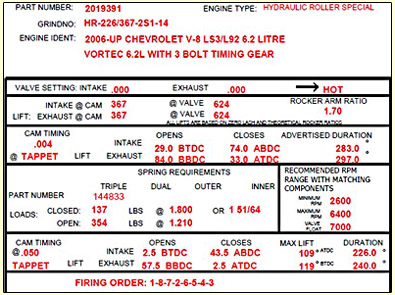
The 3 camshafts in this comparison are the most popular grinds that Crane offers for the LS3 – part numbers 2019371, 2019381, and 2019391 available from Marken Performance. All three cams are based around either Crane’s LSHS347 or LSHS367 lobe profile families, or a combination of both. With a 1.70:1 rocker arm ratio, the valve lift of these lobes are .590” and .624” respectively. All three of the Crane Cams tested were 3-bolt, non-VVT cams.
The test mule engine used for the cam comparison was an L99 that was pulled from a 2010 Camaro SS and promptly converted to LS3 specs. The guys from Crane deleted all of the Active Fuel Management and Variable Valve Timing components, and completed the LS3 conversion by installing a stock LS3 cam along with a set of Crane’s performance valve springs to handle the higher lift of the bigger cams when it came time to test them. It should also be noted that L99 engines also have heavier valves and slightly less compression than the LS3 in addition to the AFM and VVT. Crane upgraded the L99's valve springs during the LS3 conversion to simplify the cam swap process on the dyno. However, even with a slight handicap compared to a true LS3, the baseline numbers of the converted and properly tuned L99 are actually pretty shocking. The stock engine base made exactly 461.5 horsepower at 5,900 RPM, and 455.8 pound feet of torque at 4,800 RPM on the engine dyno. You can chalk up most of the gains over a stock LS3′s 426 horsepower and 420 pound-feet of torque to the optimized tune. Regardless, it’s a really great starting point.
All of the tests were performed on an engine dyno, so the numbers you see listed throughout this article are quoted as horsepower measured at the flywheel.
The cams for this comparison were tested in order from mildest to wildest, starting with Crane’s # 2019371 cam. This cam delivers 216°/232° degrees of duration with .590”/.624” lift. The LSA on this cam is 113°, creating two degrees of overlap. These specs point to a very good street-performance LS3 cam. The 371 may be considered pretty mild by most standards, but this tiny bump stick absolutely woke up the LS3. The dyno sheets show us that it made right at 500.9 peak horsepower at 6,100 RPM. That’s a total gain of 39 horsepower at the flywheel just by installing a small and very streetable cam. Peak torque was at 4,800 RPM – the same as stock – but made 488.4 pound feet of torque versus the stock cam’s 455.8 pound feet.
Next up was the slightly more aggressive # 2019381 cam, which has the same amount of lift as the #2019371, at 0.590”/0.624”. However the 381 cam has slightly more duration at 220°/236° degrees, and a 113° LSA. This would be a good compliment to other basic bolt-ons like a cold air intake, headers, and a cat-back. It will have slightly more lope to it, but it would still be relatively mild mannered in a street car. It also shouldn’t take an arm and a leg worth of tuning to get the best results. Even just a slight bump in duration with the #2019381 cam paid huge dividends in the power production. Horsepower jumped to 520.0 at 6,400 RPM, with torque registering 492.0 pound feet still at the same peak RPM as stock. That’s a massive bump of 60 horsepower over stock, and a solid 20 horsepower increase over the milder #2019371 cam.

 The final and largest cam included in Crane’s LS3 cam comparison was the # 2019391 which boasts 226°/240° degrees of duration and .624” lift on both the intake and exhaust. The LSA is 114° degrees with a total of five degrees of overlap. This cam could be categorized as a hot street/strip type cam. As far as drivability goes, some guys would never consider this cam for a street car because it would be too wild, while others might look at this as just a baby cam. However, it would still be on the streetable spectrum by the majority of people’s definition, and should deliver a very nice choppy idle. This cam is where you start to get into the upper limits of the stock long block as far as the piston-to-valve clearance goes. You’ll notice that the duration split between the intake and exhaust isn’t quite as great as the other two cams; the reason is to help provide exhaust valve clearance. The #2019391’s increased duration and intake lift pushed the power band up to 6,500 and made 14 more horsepower than the slightly milder #2019381 cam. It did make less torque than the previous cam, peaking at a slightly higher RPM, but that’s to be expected with this cam’s duration and LSA. The big story here is the power increase over stock with the #2019391– a whopping 72 horsepower and 32 pound feet of torque.
The final and largest cam included in Crane’s LS3 cam comparison was the # 2019391 which boasts 226°/240° degrees of duration and .624” lift on both the intake and exhaust. The LSA is 114° degrees with a total of five degrees of overlap. This cam could be categorized as a hot street/strip type cam. As far as drivability goes, some guys would never consider this cam for a street car because it would be too wild, while others might look at this as just a baby cam. However, it would still be on the streetable spectrum by the majority of people’s definition, and should deliver a very nice choppy idle. This cam is where you start to get into the upper limits of the stock long block as far as the piston-to-valve clearance goes. You’ll notice that the duration split between the intake and exhaust isn’t quite as great as the other two cams; the reason is to help provide exhaust valve clearance. The #2019391’s increased duration and intake lift pushed the power band up to 6,500 and made 14 more horsepower than the slightly milder #2019381 cam. It did make less torque than the previous cam, peaking at a slightly higher RPM, but that’s to be expected with this cam’s duration and LSA. The big story here is the power increase over stock with the #2019391– a whopping 72 horsepower and 32 pound feet of torque. DYNO TABLES:


News
- Mar 26 2019 EBC New RP-1 Brake Pads for Racing
- Mar 11 2019 Bushwacker DRT Style™ Fender Flares
- Feb 23 2019 Flowmaster Cat-Back 717889 fits 2019 RAM 1500 Hemi
- Feb 11 2019 Optima Yellowtop Rectangle Battery # 9048-148, H6 Group 48
- Jan 18 2019 Holley New Larger EFI Pro Dash
- Jan 08 2019 Lucas Oil Low Viscosity Stabilizer #11097 + #11096 Intake Cleaner for Gasoline Direct Injection Engines
- May 05 2018 Thermo-Tech Rogue Series T3, T4 Turbo Cover
- Apr 30 2018 Holley’s Mid-Mount Kit # 20-200 for LT Swap, with accessories
- Apr 27 2018 SCT BDX Performance Programmer + Monitor + Adjustments
- Apr 23 2018 ReadyLift 7 inch Lift for 2014_UP Chevy 1500
Industry News
Loading


You must login to post comments.